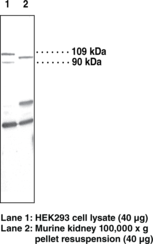| References |
| Synonyms |
- PPARγ Coactivator 1
- Peroxisome Proliferator-activated Receptor γ Coactivator 1
|
| Formulation |
Protein-A purified IgG, lyophilized |
| Stability |
2 years |
| Storage |
-20°C |
| Shipping |
Wet ice
in continental US; may vary elsewhere
|
| Specificity |
| Human PGC-1α |
+ |
| Murine PGC-1α |
+ |
| Rat PGC-1α |
+ |
| PGC-1β |
+ |
Show all 4
Hide all but first 3
|
Background Reading
Lin, J., Puigserver, P., Donovan, J., et al. Peroxisome proliferator-activated receptor g coactivator 1b (PGC-1b), a novel PGC-1-related transcription coactivator associated with host cell factor. J Biol Chem 277(3) 1645-1648 (2002 Jan 18).
Lin, J., Handschin, C., and Spiegleman, B.M. Metabolic control through the PGC-1 family of transcription coactivators. Cell Metab 1 361-370 (2005 Jun 1).
Larrouy, D., Vidal, H., Andreelli, F., et al. Cloning and mRNA tissue distribution of human PPARγ coactivator-1. Int J Obes 23 1327-1332 (1999).
Flier, J.S. Obesity wars: Molecular progress confronts an expanding epidemic. Cell 116 337-350 (2004).
Meirhaeghe, A., Crowley, V., Lenaghan, C., et al. Characterization of the human, mouse, and rat PGC1b (peroxisome-proliferator-activated receptor-g co-activator 1b) gene in vitro and in vivo. J Biochem 373 155-165 (2003 Apr 3).
Show all 5
Hide all but first 3
| Size |
Global Purchasing |
| 500 µl |
|
Description
Antigen:
human PGC-1α amino acids 75-90 (NIFEKIDEENEANLLA)
·
Host:
rabbit
·
Application(s):
WB and IHC (paraffin-embedded tissue sections); other applications not tested
·
Three peroxisome proliferator-activated receptor γ coactivator 1 (PGC-1) isoforms have been characterized - PGC-1α, PGC-1β, and PGC-1-related coactivator (PRC). PGC-1α and PGC-1β are products of two distinct genes with protein sequences sharing high homology at both the N- and C-terminus.1 PGC-1α is a tissue-specific and inducible transcriptional coactivator for several nuclear receptors and plays a key role in energy metabolism, hepatic gluconeogenesis, and cholesterol homoeostasis.2 PGC-1β is also thought to activate oxidative metabolism in tissues, although it does so through a relatively restricted set of transcriptional partners compared to PGC-1α. PGC-1α is most abundant in kidney and heart whereas PGC-1β is primarily expressed in heart, brown adipose, and skeletal muscle.3,4 Changes in PGC-1α levels may play a role in metabolic disorders such as type II diabetes and obesity5 Human PGC-1α is 798 amino acids in length with a calculated molecular weight of 91 kDa. Cayman’s PGC-1 polyclonal antibody detects the protein at around 96 kDa in murine kidney and liver samples. In human liver microsomes and HEK293 cells, both PGC-1α and PGC-1β are detected.
1
Lin, J., Puigserver, P., Donovan, J., et al. Peroxisome proliferator-activated receptor g coactivator 1b (PGC-1b), a novel PGC-1-related transcription coactivator associated with host cell factor. J Biol Chem 277(3) 1645-1648 (2002 Jan 18).
2
Lin, J., Handschin, C., and Spiegleman, B.M. Metabolic control through the PGC-1 family of transcription coactivators. Cell Metab 1 361-370 (2005 Jun 1).
3
Larrouy, D., Vidal, H., Andreelli, F., et al. Cloning and mRNA tissue distribution of human PPARγ coactivator-1. Int J Obes 23 1327-1332 (1999).
4
Meirhaeghe, A., Crowley, V., Lenaghan, C., et al. Characterization of the human, mouse, and rat PGC1b (peroxisome-proliferator-activated receptor-g co-activator 1b) gene in vitro and in vivo. J Biochem 373 155-165 (2003 Apr 3).
5
Flier, J.S. Obesity wars: Molecular progress confronts an expanding epidemic. Cell 116 337-350 (2004).
|






